Biology
Water will flow from areas of high concentration to areas of low concentration, just as the salts and sugars will. This is diffusion, but in the case of water it is called osmosis (Plants That Don't Sleep Well). The solvent (water) and solutes (those things dissolved in the solvent) try to balance their concentrations, so water flows out of the cell and salts or sugars flow in. The result is pandemonium, chemical reactions are not possible under these conditions, and the organism either dies or goes into stasis.
Parthenogenesis occurs when the unfertilized egg receives the messages necessary to begin to divide and form an embryo. The offspring have only their mother?s DNA with which to work, so they are all clones and all female. The egg does have two copies of the chromosomes, but this can occur in two ways. If the egg is haploid but undergoes chromosome doubling, the resultant offspring is a half-clone of the mother. But if the egg is produced only by mitosis, with no meiotic event to result in a haploid gamete, then the offspring is a full clone.
Mistletoe ? These are evergreen, hemi-parasitic plants that grow in many parts of the world. They have photosynthetic leaves, so they produce their own carbohydrates and energy, but they rely exclusively on their host tree for water and minerals. The mistletoe roots bore into the host bark and vascular tissue to obtain the water and minerals it needs.
The name, mistletoe, is not something commonly brought up at a holiday party. From the Old English word, ?mistiltan,? the name tells it all. Birds eat the fruit and seeds of the plant and some of them pass through the GI tract unaltered. When excreted (mistil means dung), the sticky seeds may germinate on a limb (tan means branch). Interesting, but try not to mention it over a bowl of holiday punch.
The concepts discussed here will be discussed in more detail in other posts. Resources will be provided on those occasions.
- #41 Transport In Phloem
The movement of substances in phloem tissue is called translocation. The main substances that are moved are sucrose and amino acids, which are in solution in water. These substances have been made by the plant and are called assimilates. Phloem...
- Pollen: Evolution
In this picture is pollen that got stuck to the ground because of juice or water. Pollen has been flying around because plants and flowers are blooming and they are ready to fertilize. Pollen is like a tiny grain inside id a seed plant which usually...
- Christmas Greenery - Friend Or Foe?
Biology concepts ? toxin, botany, cancer chemotherapies, pregnancy, evergreen Noche de Rábanos (Night of the Radishes) is celebrated in Oaxaca, Mexico on December 23. The townspeople carve radishes into shapes, characters or scenes and then they...
- Christmas Trees Have Trouble Seeing The Light
Biology concepts ? photoprotection, photosynthesis, non-photochemical quenching, reaction center, yule, evergreen, chlorophyll Yule was/is a pagan celebration in midwinter. Krampus was the spirit who came during Yule to punish children who had misbehaved....
- Do You Drink Like A Fish?
Biology concepts ? fish osmoregulation, shark osmoregulation, semelparity, iteroparity The irony of fish drinking is not lost on this café in the Hotel Portofino at Universal Orlando. What I really like is the eye patch.You?d think that fish would never...
Biology
The Life Of The Party
Biology concepts ? plant adaptations, osmosis, parthenogenesis
Last week we discussed the biological implications of an old Christmas carol. Today?s post is a hodgepodge of holiday biology, but we can still find some exceptions.
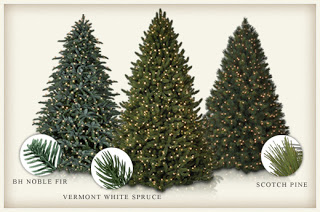 |
From a distance, spruce, fir, and pine Christmas trees look similar. The differences are mostly in the needles, both shape and number. |
Christmas trees ? There are many different types of trees used for Christmas, but they are all evergreens. This is the reason they were used in the first place. The tradition sprung from old pagan ceremonies that reminded us that spring would come and there would be a rebirth of greenery.
Evergreens have a thick wax coating on their needles (these are actually their leaves). This adaptation, as well as the low surface area of each leaf, helps to reduce water loss during the arid winter.
The resin of evergreens is higher in sugar than in other trees species. This keeps the liquids in the tree from freezing solid during the cold months. The higher sugar content oozes from the bark and at the collars of the branches, and is very sticky (picture Chevy Chase in Christmas Vacation).
The resin of evergreens is higher in sugar than in other trees species. This keeps the liquids in the tree from freezing solid during the cold months. The higher sugar content oozes from the bark and at the collars of the branches, and is very sticky (picture Chevy Chase in Christmas Vacation).
Evergreen is a characteristic not a botanical grouping. They tend to photosynthesize all winter long, given enough water and sunlight. In deciduous trees there are hormonal (phytohormonal) signals that induce cleavage of the leaves from the stems (abscission) when there is not enough sunlight to justify making chlorophyll. In evergreens, there is some of this signal present, and pines do lose leaves in the winter, just not all of them. When cut and kept indoors, the abscission signal is increased, and together with the reduced water ? all the needles end up on your carpet.
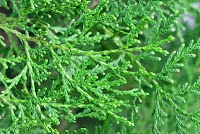 |
The leaves of cedar Christmas trees look different from other evergreens. If you choose a red cedar, just remember that there is actually no evidence that they keep moths away. |
The groups of trees used for Christmas are members of the conifers ? cedar, fir, and pine, and spruce. In general, pines have two or three needles coming from the same place on the twig, while fir and spruce usually have just one. To tell fir from a spruce, try to roll a needle in your fingers; if flat and won?t roll, it is probably a fir, but if it is four sided and can be rolled, it is a spruce. Cedars look different from the other three, they have scale-like leaves and ball cones, and their bark is more splintered.
Christmas cactus ? This is a small genus of plants, comprised of two groups, the truncata and the buckleyi. In the wild, they grow on other plants (epiphytic) or on rocks (epilithic). They don?t have leaves, common in cacti, their flattened green stems serve as their photosynthetic elements. They occur in naturally in eastern Brazil, along the coast of the Atlantic Ocean. Those for sale in the U.S. are cultivars, bred for hardiness and different colors, different plants will bloom in red, yellow orange, or pink.
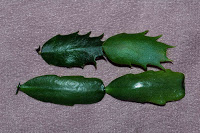 |
Thanksgiving cactus stem is shown on the top, while the bottom stem is from a Christmas cactus. |
In Brazil, the cacti are called May Flowers, reflecting the month in which they bloom in the Southern Hemisphere. In the northern latitudes, they flower from November through January, depending on the cultivar. This presented a classic opportunity for commercialization.
You might want to look at your Christmas cactus a little more closely; you might actually have a truncata when you think you have a buckleyi. The Christmas cactus has stem segments that are rounded, with more symmetric points. The flowers hang down low and their pollen is pink. These flowers generally bloom later and these buckleyi cultivars therefore termed the Christmas cactus.
 |
The yellow pollen on the left is characteristic of a Thanksgiving cactus. The pink pollen of the flower on the right is typical of the Christmas cactus. |
In contrast, truncata cacti have much sharper stem segments. If it hurts to prune your cactus, you may have one of these. The flowers stay closer to horizontal, or even rise up on the plant. The pollen grains are yellow, so there are several ways to tell these plants apart. Perhaps the best way is by the blooming time. The truncata will bloom closer to the end of November. For this reason, they are often called Thanksgiving cacti. Still think you have a Christmas cactus?
Fruitcake ? I am an unapologetic fruitcake fanatic. To everyone who isn?t - stop making fun and just send them to me.
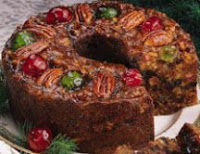 |
Fruitcake! It may be my favorite holiday treat. |
The biology of fruitcake is based on bacteria, or more correctly, the lack of bacteria. The candied fruits used in fruitcake are not just dried, they are preserved. For many centuries, fruits were precious commodities, especially in the winter. The vitamin C and other nutrients were needed for good health, but spoilage kept most people from having them during the colder weather.
Meats were preserved with salt, called curing, since the days of the ancients. Fruits, on the other hand, don?t taste so good when salt cured. It turned out sugar that could preserve fruits just as salt cured meats. Either liquid syrup or crystalline sugar would do the job, but sugar was very costly. Honey could do the job, but not as well, and it wasn?t much more available. Therefore, preserved fruits were a luxury for some period of time.
With the advent of sugar beet production in the Americas in the late 1500?s and the resulting availability of sugar in Europe, there was a candied fruit glut in Europe. It became more common to use them in baking. Italian pannatone, and fruitcakes were common uses.
So how do salt and sugar preserve foods? It all has to do with water. Bacteria need water to survive; if you remove the water, you stop (or at least slow) bacterial growth. An osmotic gradient is set up when cells are placed in high salt (hypertonic) or high sugar environment. If the salt or sugar content is higher outside the cell, it means that the water concentration is higher inside the cell.
 |
In osmosis, water flows from where there is little solute toward where there is much solute. In hypertonic solution, this means water leaves the cell. |
Dehydration by salt and sugar work in several ways. One, removing water through osmotic pressure will turn the bacteria, fungi, and parasites already on the food to dried up corpses by pulling out their water. Second, the lack of water in the preserved food stops bacteria and other microbes that might land on them from propagating; no water, no cell division.
Third, the high salt or sugar concentrations, even with some water present, limits the species of organisms that could grow there. Only a few microbes, called halophiles (hal = salt, and phile = lover) can grow in high salt environments. Similarly, honey is only about 30% water, so not many bacteria can grow in this low water/high sugar environment (but some important bacteria can, so don't give raw honey to infants). Finally, the loss of water in the foodstuffs reduces the oxidation reactions that might take place to age the food. Fats are especially susceptible to oxidation, they go rancid in not too long. The curing of meats slows this process, but is less a problem in fruits due to the low fat content.
Those fruitcakes deserve a little more credit, don?t they? And by the way, fruitcakes are not the doorstops everyone thinks they are, they actually float in water.
Virgin birth ? I will only touch on this subject, as the blog will soon be delving into a series of stories on mating and reproduction. There are many species of animal that can give birth to viable young without mating. This is called parthenogenesis (partheno = virgin, and genesis = birth).
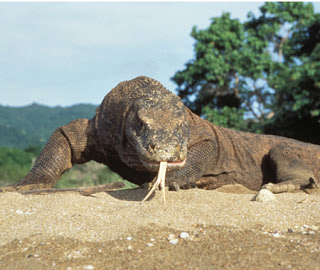 |
In 2005, a komodo dragon in a zoo laid some eggs. No big deal, except she hadn?t been housed with a male for 2 years! Apparently, they can reproduce sexually, or by parthenogenesis if no males around. This has changed how komodos are housed in zoos. |
Many species use parthenogenesis exclusively, or in response to environmental or population conditions. Whiptail lizards, as well as aphids and some plants, are famous for undergoing parthenogenesis. No cases of mammalian parthenogenesis have been documented in the wild, but stem cells have been developed by parthenogenesis in the laboratory. Anyway, if the Christmas story was going to rely on parthenogenesis, then Jesus should have been a baby girl.
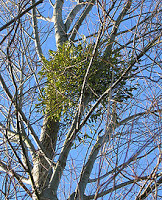 |
Mistletoe is an evergreen that grows on other plants. It can draw water from the host even in winter. It also draws animals to the tree in winter. |
The mistletoe can serve to hurt the host plant, especially if it grows too well, but they can also help the host. Junipers that harbor mistletoes produce more berries than those without. This is due to the large number of birds that come to eat the mistletoe berries; the juniper takes advantage. This makes it hard to determine of the symbiosis of mistletoe/host is parasitism or perhaps mutualism.
 |
As the berry passes through the bird, it releases sticky cellulose fibers that help the seed stick to an unfortunately placed branch. |
The white berries of the mistletoe played a role in the 18th century Christmas kissing tradition. In Scandinavia, the maid under the mistletoe could be kissed, but the gentleman had to pull off a berry each time. While the berries were gone, the kissing privilege was lost.
Next time we will finish our stories on sleep and activity by talking about introduced species. Then we will start a series of posts on the incredible worlds of water and salts in biology. Our fruitcake discussion above may serve as a great introduction, but it is just the tip of the iceberg.
- #41 Transport In Phloem
The movement of substances in phloem tissue is called translocation. The main substances that are moved are sucrose and amino acids, which are in solution in water. These substances have been made by the plant and are called assimilates. Phloem...
- Pollen: Evolution
In this picture is pollen that got stuck to the ground because of juice or water. Pollen has been flying around because plants and flowers are blooming and they are ready to fertilize. Pollen is like a tiny grain inside id a seed plant which usually...
- Christmas Greenery - Friend Or Foe?
Biology concepts ? toxin, botany, cancer chemotherapies, pregnancy, evergreen Noche de Rábanos (Night of the Radishes) is celebrated in Oaxaca, Mexico on December 23. The townspeople carve radishes into shapes, characters or scenes and then they...
- Christmas Trees Have Trouble Seeing The Light
Biology concepts ? photoprotection, photosynthesis, non-photochemical quenching, reaction center, yule, evergreen, chlorophyll Yule was/is a pagan celebration in midwinter. Krampus was the spirit who came during Yule to punish children who had misbehaved....
- Do You Drink Like A Fish?
Biology concepts ? fish osmoregulation, shark osmoregulation, semelparity, iteroparity The irony of fish drinking is not lost on this café in the Hotel Portofino at Universal Orlando. What I really like is the eye patch.You?d think that fish would never...
